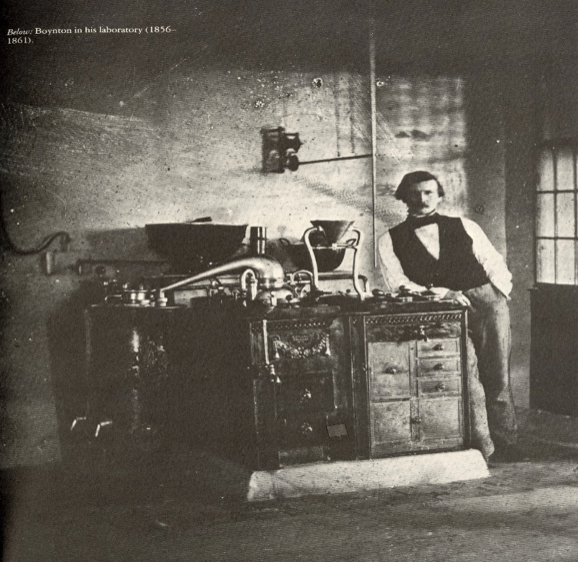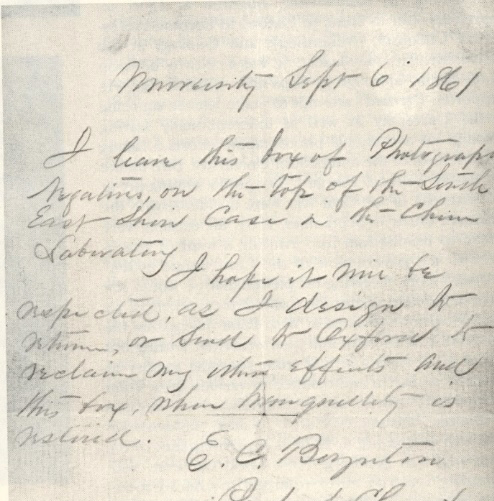Boynton’s Glass Plates

Edward Carlisle Boynton in his laboratory (1856-1861)
J.D. Williams Library’s Department of Archives and Special Collections held an exhibit from April to August 1979 featuring the University of Mississippi’s formative history. A catalogue of the exhibit became a book published by the library archives under Dr. Thomas M. Verich, then Head of Special Collections and University Archivist. The image above is taken from that catalog. It is a print made from a set of glass plate negatives that are part of the University Archives Photographs Collection. The creator of the glass plate negatives was a UM professor named Edward C. Boynton (Lloyd, Verich, and Thiel, 1979, 15).
Edward C. Boynton was Professor of Chemistry, Minerology, and Geology at the university from 1856-1961. His photographs include images of the original three-story Lyceum which held the library, lecture rooms, and chemistry laboratory, along with dormitories and Steward’s Hall that housed students and faculty near the central building in 1848 (Lloyd, 1979, p.14). Boynton took the only known photograph of an enslaved individual on the campus (Lloyd, 1979, p.18-19). He photographed fist fighting and duels taking place among students near the Lyceum from 1848-1861, that resulted in attempted bans on weapons and expulsions (14).
Lloyd notes that Boynton was not a hobbyist photographer. “He later wrote on photography as applied to military purposes,” says Lloyd, noting Matthew Brady’s use of glass plate negatives in photographing the Civil War. Glass plate negatives “advanced the process of photography past daguerreotype and calotypes” (19).
Joe Moody is the audio-visual librarian for the University of Mississippi. He is currently working on a project involving the digitization of glass plate negatives. “In the later 1800s going into to the 1900s, pictures were preserved on glass plates and the results are still spectacular. Clearly, the popularity of this format faded as more convenient methods were introduced. With glass plate negatives, not only does one need to be concerned with the glass breaking but also with the emulsion peeling or tearing off due to humidity or improper handling (not wearing the correct gloves, etc.), but convenience doesn’t always mean improvement.” Moody says, “Actually, I am really impressed with the quality that this technology continues to provide. Some of these glass plate images are amazing!”
 |
 |
| Boynton’s Handwritten Letter and Transcription of the Letter | |
Boynton left a letter indicating where he stored his glass plate negatives when he left the university after his employment ended in 1861. He had planned to reclaim his glass plate negatives or send a request for them to Oxford. As a supporter of Chancellor Barnard who also sided with the Union, Boynton was dismissed from his position. After leaving Oxford, he went back to West Point where he had graduated in 1846 (13). He returned to civilian life in 1872, but he did not return to Oxford to retrieve his box of photographic negatives. Fortunately, the university preserved these irreplaceable pieces of its history. A significant number of the images including the letter from Boynton’s collection are digitized and available to view in eGrove, the University of Mississippi’s digital repository.
Jeannie Speck Latartara, University Archivist and Assistant Professor
Joe Moody, Special Collections Librarian (Audio-Visual) and Assistant Professor
